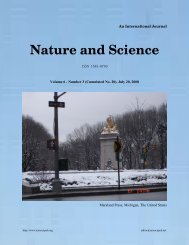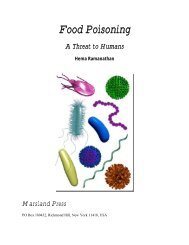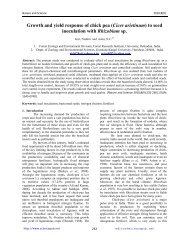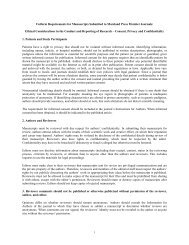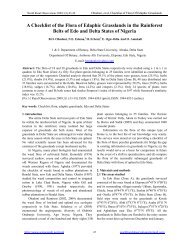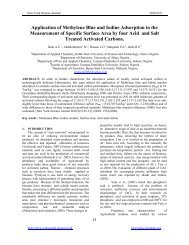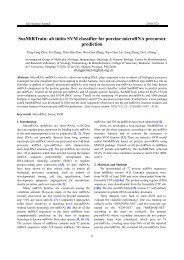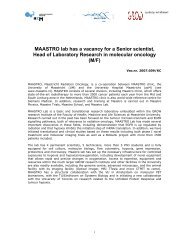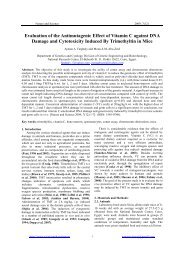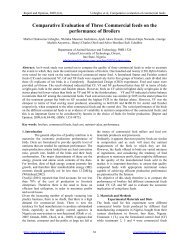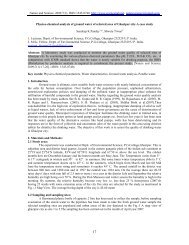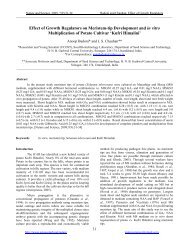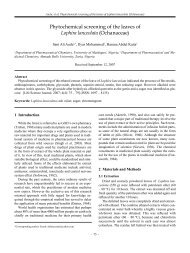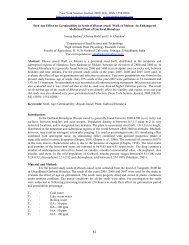Ecological, Social and Commercial Role of Lichens in India with ...
Ecological, Social and Commercial Role of Lichens in India with ...
Ecological, Social and Commercial Role of Lichens in India with ...
You also want an ePaper? Increase the reach of your titles
YUMPU automatically turns print PDFs into web optimized ePapers that Google loves.
Acdemia Arena 2010, Supplement 0201<br />
http://www.sciencepub.net<br />
them was occupied by the great geosyncl<strong>in</strong>als Tethys Sea. The probable date <strong>of</strong> the commencement<br />
<strong>of</strong> the elevation <strong>of</strong> the Himalayas is about the close <strong>of</strong> the Mesozoic period, but the unveil<strong>in</strong>g <strong>of</strong> the<br />
story <strong>of</strong> their structure has only just their beg<strong>in</strong>, <strong>and</strong> <strong>in</strong> many cases no dat<strong>in</strong>g <strong>of</strong> the rocks is yet<br />
possible, though they <strong>in</strong>clude ancient <strong>and</strong> relatively recent crystall<strong>in</strong>e <strong>in</strong>trusive, rocks <strong>and</strong><br />
sediments allied to the pen<strong>in</strong>sular part <strong>of</strong> the <strong>India</strong>. The section <strong>of</strong> the range <strong>in</strong> the district is deeply<br />
cut <strong>in</strong>to by the headwaters <strong>of</strong> the Alakn<strong>and</strong>a River, this trunk stream seem<strong>in</strong>g to have reached a<br />
latter stage <strong>of</strong> development than its tributaries. This much, however is known that there has been<br />
<strong>in</strong>tense metamorphosis. In some part uplift has been considerable s<strong>in</strong>ce the mid Pleistocene period,<br />
<strong>in</strong> others there are great stretchers <strong>of</strong> high but subdued topography <strong>and</strong> elsewhere there are the<br />
deepest gorges. The direction <strong>of</strong> fold<strong>in</strong>g <strong>in</strong> these mounta<strong>in</strong> masses is generally North-South. The<br />
geological features <strong>of</strong> the district from two major divisions which lies North <strong>and</strong> South <strong>of</strong> an<br />
imag<strong>in</strong>ary l<strong>in</strong>e extend<strong>in</strong>g East-South-East between the villages <strong>of</strong> Helang <strong>in</strong> Joshimath <strong>and</strong><br />
Loharkhet <strong>in</strong> the Adjo<strong>in</strong><strong>in</strong>g district <strong>in</strong> Pithoragarh. The Northern division, which is occupied by<br />
higher range <strong>and</strong> snow covered peaks consist entirely <strong>of</strong> medium to high grade metamorphic rocks<br />
<strong>and</strong> is <strong>in</strong>truded by later volcanic rocks. The division <strong>of</strong> the South, occupied by ranges <strong>of</strong> lower<br />
altitude, consists essentially <strong>of</strong> sedimentary <strong>and</strong> low grade metamorphic rock also <strong>in</strong>truded by later<br />
volcanic rocks. Geologically very little is known <strong>of</strong> the first division which consists <strong>of</strong> rocks such<br />
as quartzite’s, marbles <strong>and</strong> various types <strong>of</strong> micaceous schist’s <strong>and</strong> gneisses which a few sporadic<br />
occurrences <strong>of</strong> garnet, graphite, iron, knit mica <strong>and</strong> ve<strong>in</strong> quartz. The division <strong>of</strong> the South <strong>of</strong> the<br />
imag<strong>in</strong>ary l<strong>in</strong>e is better known geologically <strong>and</strong> consists <strong>of</strong> rocks such as gneisses, limestone,<br />
phyllites, quartzite, Seri cite biotic chests <strong>and</strong> slates.<br />
Soils <strong>in</strong> the region are the coarse soils, well dra<strong>in</strong>ed <strong>and</strong> acidic <strong>with</strong> pH levels vary<strong>in</strong>g<br />
between 4 to 5.5 (Sundriyal 1992).<br />
Climate<br />
As the elevation <strong>of</strong> the district ranges from 800mts to 8000 mts above sea level the climate<br />
<strong>of</strong> the region very largely depend on altitude. The w<strong>in</strong>ter season is from about mid November to<br />
March. As most <strong>of</strong> the region is situated on the Southern slopes <strong>of</strong> the outer Himalayas, monsoon<br />
currents can enter through the valley, the ra<strong>in</strong>fall be<strong>in</strong>g heaviest <strong>in</strong> the monsoon form June to<br />
September.<br />
Ra<strong>in</strong>fall<br />
Most <strong>of</strong> the ra<strong>in</strong>fall occurs dur<strong>in</strong>g the period June to September when 70 to 80 percent <strong>of</strong><br />
6



